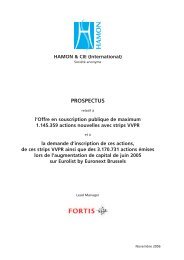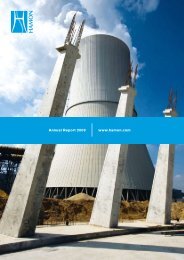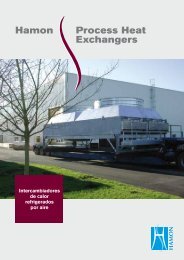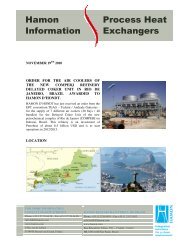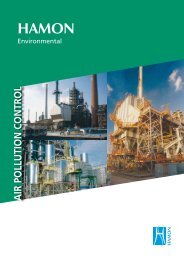Download PDF version English (3237KB) - Hamon
Download PDF version English (3237KB) - Hamon
Download PDF version English (3237KB) - Hamon
Create successful ePaper yourself
Turn your PDF publications into a flip-book with our unique Google optimized e-Paper software.
Part 3 - Financial statements<br />
65<br />
liabilities and contingent liabilities recognized. The initial<br />
accounting for business combinations is not restated.<br />
Any adjustments to the consideration transferred<br />
in these business combinations changes their initial<br />
accounting and leads to a matching adjustment to<br />
goodwill.<br />
b. Business combinations carried out after<br />
1 January 2010<br />
Goodwill is measured as the excess of the aggregate of:<br />
(i) the consideration transferred;<br />
(ii) the amount of any non-controlling interests<br />
in the acquiree; and<br />
(iii) in a business combination achieved in stages, the<br />
acquisition-date fair value of the previously held<br />
equity interest in the acquiree;<br />
over the net of the acquisition-date fair values of the<br />
identifiable assets acquired and the liabilities assumed.<br />
Goodwill recognized on the acquisition date is not<br />
subsequently adjusted.<br />
Measurement of goodwill<br />
Goodwill is not depreciated but it is tested for impairment<br />
at least once a year. Any impairment loss is charged to<br />
the income statement. An impairment loss accounted<br />
for on goodwill cannot be reversed at a later date.<br />
At the time of the sale of a subsidiary or a jointly<br />
controlled entity, the relevant goodwill is included in the<br />
determination of the result of the sale. Goodwill on<br />
associated companies is presented under ‘Investments<br />
In Associated Companies’.<br />
3.4.2 Tangible Assets<br />
An item of property, plant and equipment is recognized<br />
as a tangible asset if it is probable that the future<br />
economic benefits attributable to the asset will flow to<br />
the Group and if their costs can be measured reliably.<br />
After the initial accounting, all tangible assets are<br />
stated at cost less the accumulated depreciation and<br />
impairment losses. The cost includes all the costs<br />
directly attributable to bringing the asset to the location<br />
and condition necessary for it to be capable of operating<br />
in the intended manner.<br />
Repair and maintenance costs and other subsequent<br />
expenditure linked to an asset are charged as expenses<br />
in the income statement of the financial year during<br />
which they are incurred.<br />
The depreciable amount of an asset is allocated<br />
systematically over its useful life using the straight-line<br />
method. The depreciation of an asset begins when it is<br />
available for use. The estimated useful lives of the most<br />
significant elements of tangible assets are as follows:<br />
Description<br />
Land<br />
Administrative buildings<br />
Industrial buildings<br />
Machines<br />
EDP equipment<br />
Other equipment<br />
Leasehold Improvements<br />
Tools<br />
Furniture<br />
Vehicles<br />
Useful live<br />
No depreciation<br />
33 years<br />
33 years<br />
10 years<br />
4 years<br />
10 years<br />
10 years<br />
4 years<br />
10 years<br />
4 years<br />
Depreciation charges are posted to operating expenses<br />
by reference to the function of the underlying assets<br />
(cost of sales, selling & marketing expenses, general and<br />
administration costs, research and development costs).<br />
Gains or losses arising from the sale or disposal of<br />
tangible assets are determined as the difference<br />
between the sale proceeds and the carrying amount<br />
of the asset and are charged to the income statement<br />
under ‘Other Operating Income / (Expenses)’.<br />
The Group has elected to use the cost model for the<br />
measurement of property, plant and equipment. Therefore<br />
items of property plant and equipment may not be carried<br />
at a re-valued amount after their initial recognition.<br />
Impairment of Tangible and Intangible Assets<br />
Except for intangible assets in progress that are tested<br />
for impairment annually, tangible and intangible assets<br />
are subject to an impairment test only when there is<br />
an indication that their carrying amount exceeds their<br />
recoverable amount.<br />
If an asset does not generate cash flows independently<br />
of those of other assets, the Group makes an estimate<br />
of the recoverable value of the cash-generating unit to<br />
which the asset belongs. The recoverable value is the<br />
highest value between the fair value less costs to sell<br />
and the value in use. If the recoverable value of an<br />
asset (cash flow generating unit) is lower than its<br />
carrying amount, an impairment loss is immediately<br />
recognized as an expense in the income statement<br />
either in “Other Operating Expenses” or in impairment<br />
loss on non-current assets.<br />
When an impairment is reversed at a later date, the<br />
carrying amount of the asset (cash flow generating unit)<br />
is increased to the revised estimate of its recoverable







